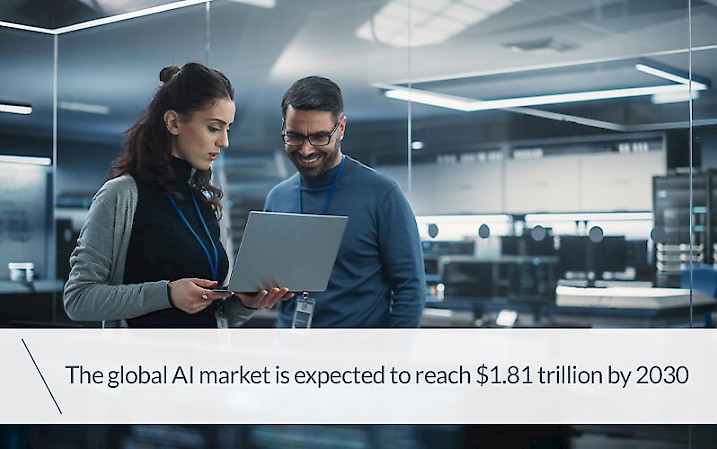
According to the report ‘Artificial Intelligence Market Size & Trends’, published by Grand View Research, the global artificial intelligence market reached USD 196.63 billion in 2023, and is expected to grow at a CAGR of 36.6% from 2024 to 2030 reaching the remarkable figure of 1,811.75 million USD.
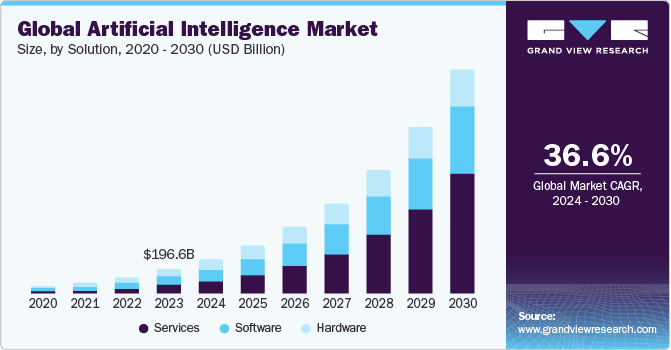
Many tech giants are working to make AI more accessible for business applications, improving the customer experience and strengthening their presence in the Artificial Intelligence 4.0 industry.
This translates into increased adoption of these advanced technologies in various verticals, such as automotive, healthcare, retail, finance and manufacturing.
Artificial intelligence: a revolution in the digital age
In recent years, particularly since the 2022 launch of ChatGPT by Open AI, artificial intelligence has emerged as a revolutionary force in the digital age. Tech giants such as Amazon, Google, Apple, Facebook, IBM and Microsoft are investing heavily in AI research and development (R&D), significantly increasing the industry's market capitalisation.
The increase in the spread of artificial intelligence globally has found application in numerous sectors.
According to the above-mentioned report, the global AI market was worth $198 billion in 2023 (and by 2024 it is expected to reach as much as $279.22 billion), split between Media and advertising, Healthcare, BFSI (Banking, financial services and insurance), Automotive and transport, Manufacturing, Retail, Agriculture, Law and other sectors.
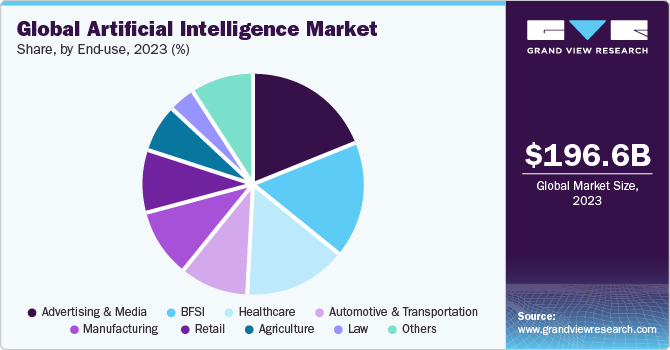
The three main segments of the pie chart we see in this graph are represented by three sectors in which AI is already playing a central role, that is to say Media and Advertising, BFSI and Healthcare:
- In 2023, the advertising and media segment led the AI market, due to the increasing application of marketing based on these tools, and is expected to grow at the fastest CAGR from 2024 to 2030
- By 2030, the healthcare segment is expected to gain dominance. This segment includes use cases such as robot-assisted surgery, dose error reduction, virtual nursing assistants, clinical trial participant identification, hospital workflow management and automated image diagnosis.
- In banking, finance and insurance (BFSI), AI is also being used for financial analysis, risk assessment and investment/portfolio management.
Other sectors are also seeing increasing use of AI tools, such as retail, where consumers are increasingly looking for personalised shopping experiences, or software development, with the growth of AIaaS (Artificial Intelligence as a Service), deep learning, data mining and virtual reality.
Finally, the role that AI is already playing in business process optimization should not be underestimated.
Global artificial intelligence market trends
We have said that the spread of next-generation artificial intelligence has found application in numerous economic and production sectors, with some differences at the global level.
Let’s take a look, therefore, at how the artificial intelligence market is divided between countries, according to 2023 figures.
North America
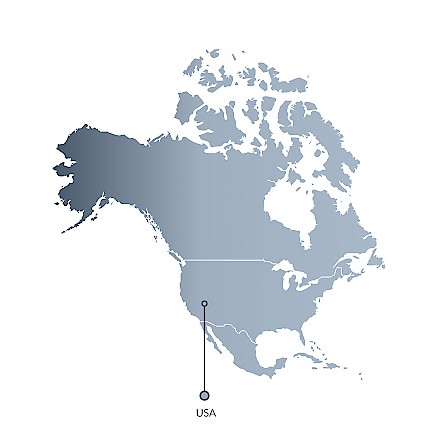
The AI market in North America accounted for a 30.9% revenue share in 2023, which encouraged favourable government initiatives encouraging the adoption of AI in various sectors.
Various countries are investing in AI research and development, establishing specialised institutes and research centres, funding projects and using artificial intelligence to improve public safety, transport and promote healthcare innovation.
USA
By 2023, the US AI market was valued at $42 billion, with significant advances in artificial intelligence and robotics.
US companies and research institutes are at the forefront of developing innovative robots that use AI to perform various tasks, including social and companion robots that interact with humans and offer assistance in varying environments.
Europe
The European AI market is expected to register a CAGR of 33.2% from 2024 to 2030.
The European financial sector is increasingly adopting AI, leading to revolutionary changes in traditional practices and improving customer experience.
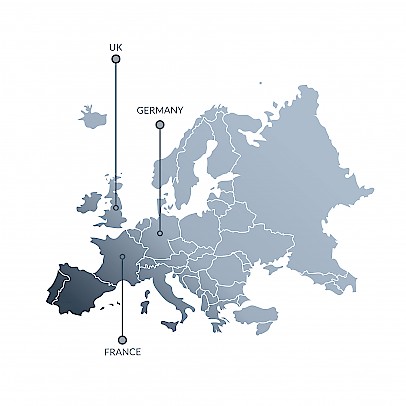
UK
In 2023, the AI market in the UK accounted for 24.8% of all European revenues.
Rapid digitisation in sectors such as banking, insurance, healthcare and business services has accelerated the growth of AI in the country.
Germany
The AI market in Germany is expected to grow at a CAGR of 30.9% from 2024 to 2030.
This growth is supported by government initiatives, such as the German AI Strategy and the AI Campus (Ki-Campus), founded by the German Federal Ministry of Education and Research (BMBF).
France
In France, the growth of the AI market is boosted by government initiatives such as the National Strategy for AI and France 2030.
An increase in R&D investments and start-ups specialising in AI will contribute to the growth of the market.
Asia Pacific (APAC)
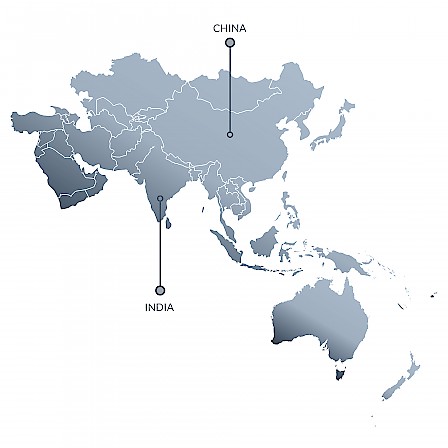
The AI market in Asia Pacific accounted for a 25.6% share of global revenue in 2023.
Various institutions in the region have already and continue to adopt artificial intelligence tools to improve educational outcomes via personalised learning experiences, intelligent tutoring systems and data analytics.
China
The AI market in China is expected to grow at a CAGR of 43.5% from 2024 to 2030 due to the implementation of AI applications in various fields, including natural language processing, computer vision, robotics, autonomous vehicles and virtual assistants.
India
The Indian AI market offers significant growth opportunities, supported by government initiatives such as the National Strategy for Artificial Intelligence, which aims to promote innovation, economic prosperity and social progress.
Middle East and Africa
The AI market in the Middle East and Africa (MEA) region is expected to reach USD 166.33 billion by 2030.
With its diverse linguistic landscape, the MEA region intends to significantly emphasise the advancement of Arabic language processing in artificial intelligence technologies.
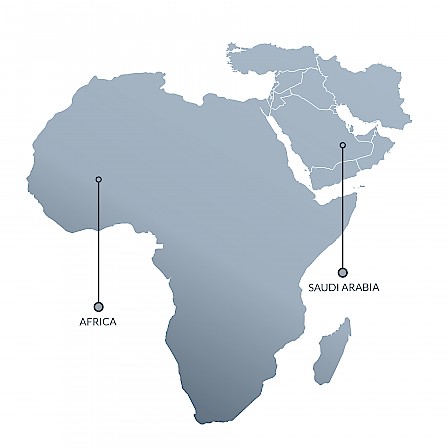
This includes natural language processing (PLN) and speech recognition capabilities that can accurately interpret and generate Arabic text and speech.
Saudi Arabia
The growth of the artificial intelligence market in Saudi Arabia is driven by a range of initiatives, policies and financial support programmes.
One example worth mentioning is undoubtedly the Saudi Data and AI Authority (SDAIA), a government agency that works to create an artificial intelligence ecosystem comprising government and private sector entities.



